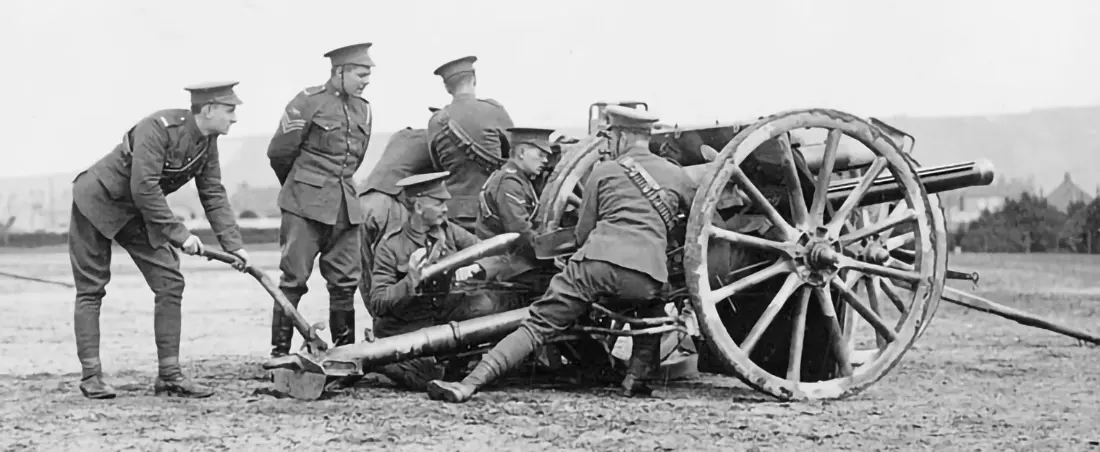Gunnery in World War I
Q.F. 18 Pounder Field Gun
The Quick Firing 18 Pounder Field Gun entered service in 1904. The Shrapnel shell fired by this gun was 3.3-inch caliber (84mm); the shell weighed 18.5-lb (8.4kg). It had a maximum range of 6,525 yards (5.96km), at an elevation of 16 degs with this distance being covered in a little over 12 seconds. The gun could elevate to 16 degrees above horizontal, which meant that its shell had a fairly flat trajectory. The gun weighed 2,821 pounds (1.282 tonnes)
This design proved to be an excellent gun, and was the main field artillery weapon employed by the British Army, and the mainstay of Divisional artillery. A Mark II design came into service in 1916, with an improved recuperator (the devices by which the gun is returned to the firing position after the rapid recoil produced when firing a shell) - the mechanical part of the gun that suffered most in conditions of prolonged firing.
The Q F 18 Pr Field gun Mk11 was issued to the 1st South Midland Brigade [T] in May 1916, replacing the 15Pdr B.L.C, which, had seen service in the Boar war.
A Mark IV (III was not used) came into service in the final months of WWI. It featured a faster loading mechanism, and allowed elevation to 30 degrees, the earlier versions could only be elevated to 16 degrees. The increased elevation gave the gun a longer range, from 6,525 yards to 11,100. With a good crew and conditions, this gun could fire H.E., at an incredible 30 rounds a minute. The 18pdr remained in service until replaced by the 25pdr starting in 1935, but some saw service in WWII.
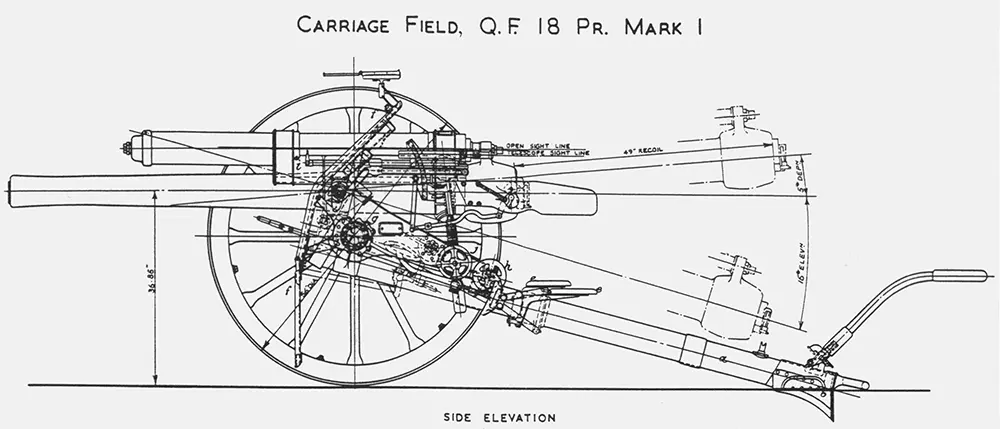
18pdr QF Field Gun Mk1
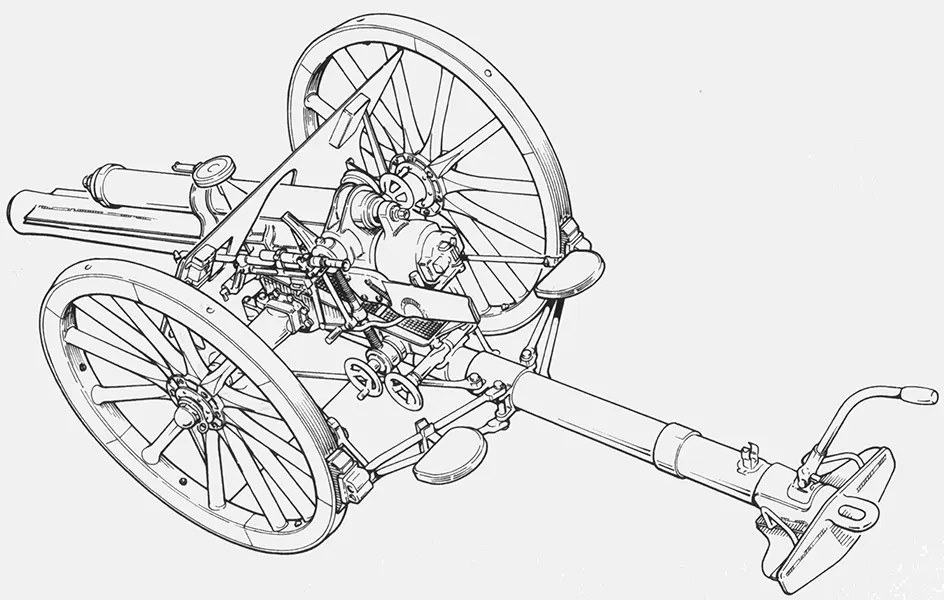
18pdr QF Field Gun Mk1
Ammunition
The Field Artillery started the war with only one type of shell for the 12/13/15/18 pdrs, this was a Shrapnel shell, for the 18 pdr it was a fixed type of ammunition, that is to say the shell and cartridge were supplied in one piece the charge inside was a standard charge which by the use of elevation the required range could be obtained.
The shell was fitted with a fuze (No 80 Mk 1V) which when set, in seconds, exploded at 30 feet above the ground, this was set with the use of a fuze key. The resulting explosion scattered 375 x 1-inch balls of made of lead and antimony in a forward and downward trajectory into the trenches and it caused many German casualties. It was also used extensively to cut the wire protecting the German trenches, but this was not very effective and was very expensive in ammunition for a very small return. The shrapnel shell was of little use against pill boxes, machine gun posts/dugouts and other hard targets especially those with good, solid overhead cover.
Why antimony? Around 10 to 13% of antimony was added to the balls to make the lead harder.
This was overcome at the end of 1915 with the issue of a high explosive (HE) shell fitted with Fuses No's 101,101E, 80 & 83 as the war progressed other types of ammunition came in to service i.e. star (Illuminating), gas, incendiary and smoke.
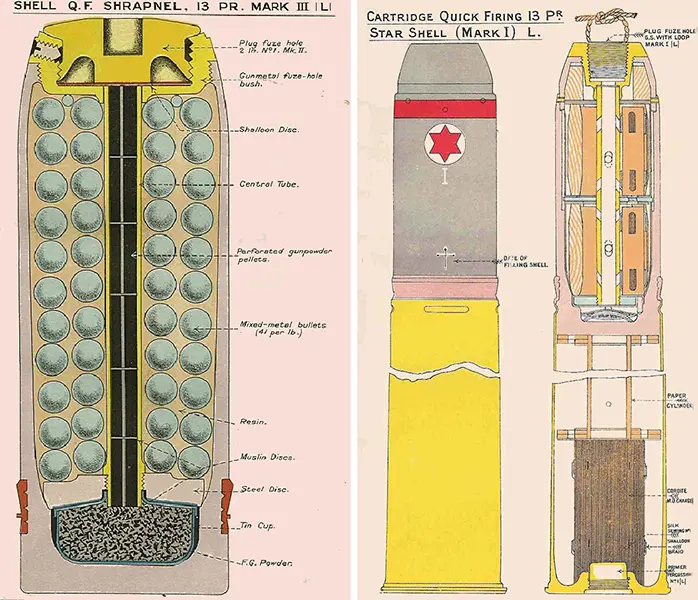
Cutaway of 13pdr shrapnell and star shells
The number of shot in a 18pdr Shrapnel shell was 375 mixed metal balls at 41 to the lb.
Click for larger image
Cartridge Clips: Were made of brass, in a cruciform shape and had a canvas strap on the top were clipped on to the base of the cartridge this was to aid the unloading or repacking of cartridges, it also served to protected the percussion primer which was set in to the base of the cartridge.
Lyddite
Picric acid is an explosive that had been used since 1830 and by 1870 most militaries were using it. In 1891, a chemist named James Dewar, who was working at the Royal Arsenal in Woolwich, England, discovered that adding castor oil to picric acid made it more stable and less sensitive to shock. The resulting explosive material named "Lyddite" after the town of Lydd in Kent, England, where it was first manufactured.
Sometimes extremely unstable explosive metallic salts such as lead picrates could form in the shell causing premature explosions such as the one that destroyed the 6 inch 26 cwt Howitzers gun of the Gloucestershire Volunteer Artillery at Staddon Heights, Plymouth on 5 June 1906. The piece was completely separate into two parts and the carriage demolished, the wheel of the neighbouring gun was also destroyed. The detachment escaped without serious injuries.
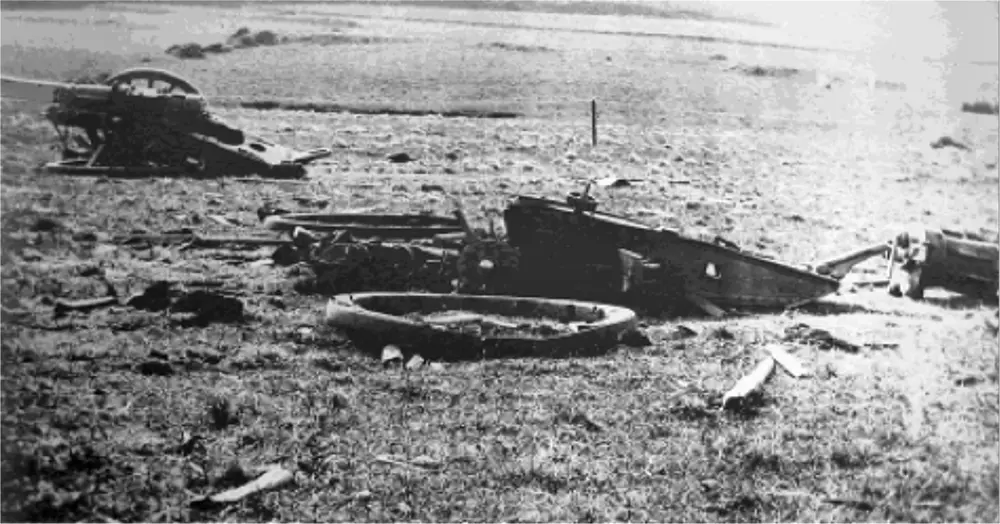
GVA gun accident 1906
The following article appeared in "Bay of Plenty Times", Volume XXIV, Issue 3940, 20 December 1899:
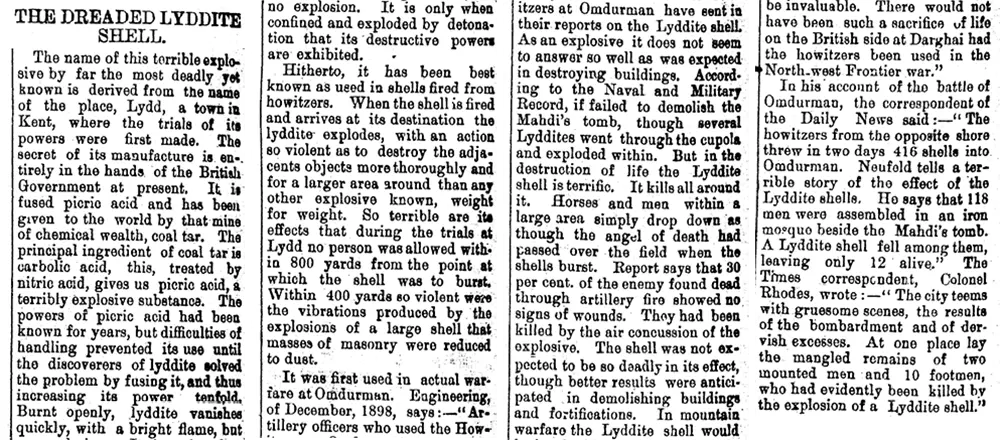
The Dreaded Lyditte Shell, 1899
The articles says:
THE DREADED LYDDITE SHELL
The name of this terrible explosive by far the most deadly known is derived from the name of the place, Lydd, a town in Kent, where the trials of its powers were first made. The secret of its manufacture is entirely in the hands of the British Government at present. It is fused picric acid and has been given to the world by that mine of chemical wealth, coal tar. The principal ingredient of coal tar is carbolic acid, this, treated by nitric acid, gives us picric acid, a terribly explosive substance. The powers of picric acid had been known for years, but difficulties of handling prevented its use until the discoverers of lyddite solved the problem by fusing it, and thus increasing its power tenfold.
Burnt openly, lyddite vanishes quickly, with a bright flame, but no explosion. It is only when confined and exploded by detonation that its destructive power are exhibited.
Hitherto, it has been best known as used in shells fired from howitzers. When the shell is fired and arrives at its destination the lyddite explodes, with an action so violent as to destroy the adjacent objects more thoroughly and for a larger area ground than any other explosive known, weight for weight. So terrible are its effects that during the trials at Lydd no person wag allowed within 800 yards from the point at which the shell was to burst.
Within 400 yards so violent were the vibrations produced by the explosions of a large shell that masses of masonry were reduced to dust.
It was first used in actual warfare at Omdurman [Sudan, 2 September 1898]. Engineering, of December, 1898, says:- "Artillery officers who used the Howitzers at Omdurman have sent in their reports on the Lyddite shell.
As an explosive it does not seem to answer go well as was expected in destroying buildings. According to the Naval and Military Record, it failed to demolish the Mahdi's tomb, though several Lyddites went through the cupola and exploded within. But in the destruction of life the Lyddite shell is terrific. It kills all around it. Horses and men within a large area simply drop down as though the angel of death had passed over the field when the shells burst. Report says that 30 per cent. of the enemy found dead through artillery fire showed no signs of wounds. They had been killed by the air concussion of the explosive. The shell was not expected to be so deadly in its effect, though better results wore anticipated in demolishing buildings and fortifications.
In mountain warfare the Lyddite shell would be invaluable. There would not have been such a sacrifice of life on the British Bide at Darghai had the howitzers been used in the North-west Frontier war."
In his account of the battle of Omdurman, the correspondent of the Daily News said:- "The howitzers from the opposite shore threw in two days 416 she11s into Omdurman. Neufeld tells a terrible story of the effect of the Lyddite shells. He says that 118 men were assembled in an iron mosque beside the Mahdi's tomb. A Lyddite shell fell among them, leaving only 12 alive." The Times correspondent, Colonel Rhodes, wrote:- "The city teems with gruesome scenes, the results of the bombardment and of dervish excesses. At one place lay the mangled remains of two mounted men and 10 footmen, who had evidently been killed by the explosion of a Lyddite shell."
Distribution of Ammunition
Early in the war the amount of ammunition expended was strictly controlled perhaps 5 or 6 rounds per day, which generated a lot of paper work if this total was exceeded, but as the war progressed and the civilian work force was mobilised the amount of ammunition produced increased, the expenditure increased also. The 1st line Ammunition, was held at the gun position (carriage limber) 24 rds in total, 2nd line Ammunition, held at the wagon lines in the Ammunition limber total 38 rds and 3rd line Ammunition at the B.A.C. (Brigade Ammunition Column) and later at the D.A.C. (Division Ammunition Column) the quantity of ammunition held by B.A.C. & D.A.C.
The ammunition was distributed to the gun positions according to the prevailing weather conditions by wagon, horse, mule and when the aforementioned could not get to the guns, because of the weather, the ammunition was carried by men carrying 4 rds in leg pouches (two either side) slung by straps over their shoulders, this method was particularly tiring when the weather was really bad, the mud would cling to their boots and they would sink into the glutinous sucking mud up to their knees and they had to be pulled out, this was a long and dirty business. Some men got lost in the dark on their way to the gun positions and fell into shell holes filled with water and drowned, others were rescued by others passing by and who had heard their shouts for help.
Battery Establishment
Each battery of the Brigade were lettered A, B & C, each of the Batteries totalled 198 men at full establishment. Each was commanded by a Major or Captain, with a Captain as Second-in-Command, and 3 Lieutenants or Second-Lieutenants in charge of 2-gun sections. Battery establishment also included a Battery Sergeant-Major (B.S.M.), a Battery Quartermaster Sergeant (B.Q.M.S.) , a Farrier-Sergeant, 4 x Shoeing Smiths (1x would be a Corporal), 2 x Saddlers (harness), 2 x Wheelers (maintained the wheels), 2 x Trumpeters, 7 x Sergeants, 7 x Corporals, 11x Bombardiers, 75 x Gunners, 70 x Drivers and 10 x Gunners acting as Batmen.
Gun Detachment Q.F. 18 Pdr Field Gun
A gun detachment consisted of 10 men;
No 1: (a Sergeant's appointment but could also carried out by a qualified Corporal) who was responsible for the gun and the crew he gave the fire orders received from the CP via the section commander, to the gun crew and manipulated the trail handle to roughly set the bearing of the gun (Hand Spike).
No 2: sat astride the right hand seat, dealt with the range wheel with his right hand and breach lever with the left.
No 3: Layer, sat on the left hand seat facing forward, set the sights to the bearing and elevation as ordered by the No1 and elevating wheel (also the traversing wheel on 18 pounders), controlled the hand brake and fired the gun when ordered.
No 4: Loader, stood on the left of the trail and loaded the rounds into the breech, responsible also for the Aiming posts and Paralleloscope.
No's 5 & 6 stood behind the limber, set the fuses and passed rounds to the No 4 Loader. No 5, Ammo Number, was also responsible for the correcting bar (barometric pressure, fuse numbers and range numbers), while No 6, Fuze Indicator.
No's 7, 8 9: In Action, would remained at the wagon lines, to assist in the re-supply of ammunition and replace casualties.
No 10: Coverer, 2 i/c of the subsection and is in charge of the gun group ammunition wagon, in action he remains at the wagon line in charge of the horse teams and wagons of his subsection.
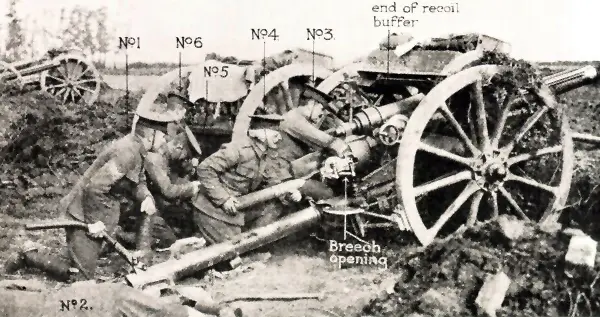
18 Pounder Gun with Crew
Photo: Wikimedia
Movement
The 18 pr gun was pulled by a 6 horse team, it also had 1 x Carriage Limber (Ammo Cart) which carried 24 rds of ammunition and 1x Ammunition Wagon limber which carried 38 rds, giving a total of 62 rds this was the First Line ammunition supply. The gun and each limber was pulled by a team of 6 horses; each team consisted of a 2 x leaders, 2 x Centers (Followers) and 2 x Wheelers. When ridden the riders mounted on the left, each Gun Detachment had 18 horses.
No's 1 and 10 on their horses on the left of the leaders of the gun and gun group wagon respectively; 2 and 3 on the gun limber; 5 and 6 on the limber; 4 on the wagon of the gun group; 7 and 8 on the limber; 9 on the wagon of the first line group; even numbers on the near side (left): odd numbers on the off side (right).
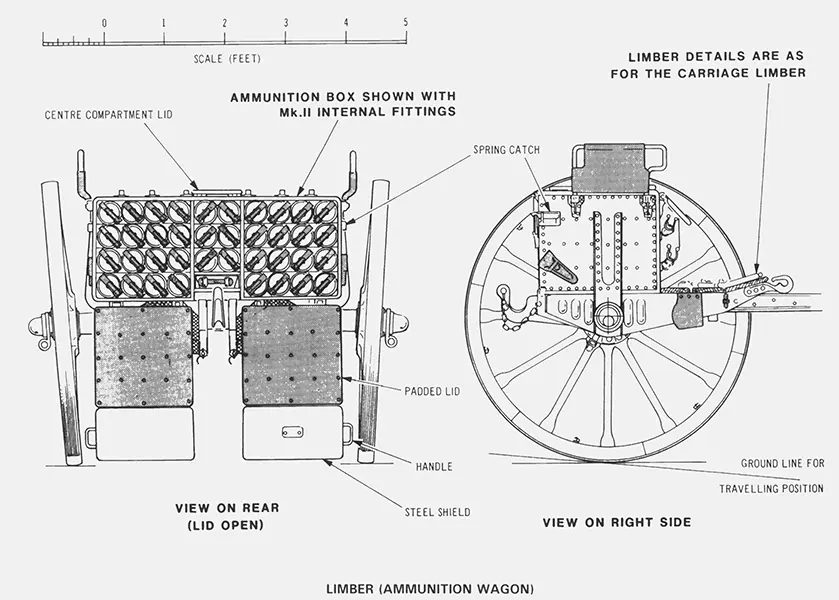
Ammo Limber
Deployment
When deployed the Battery frontage would be 120 feet, with 20ft between each gun. The ammunition carried by the Gun Limber was 24rds and the ammunition carried by the wagon Limber was 38rds, giving a 1st line ammunition total of 62 rds.
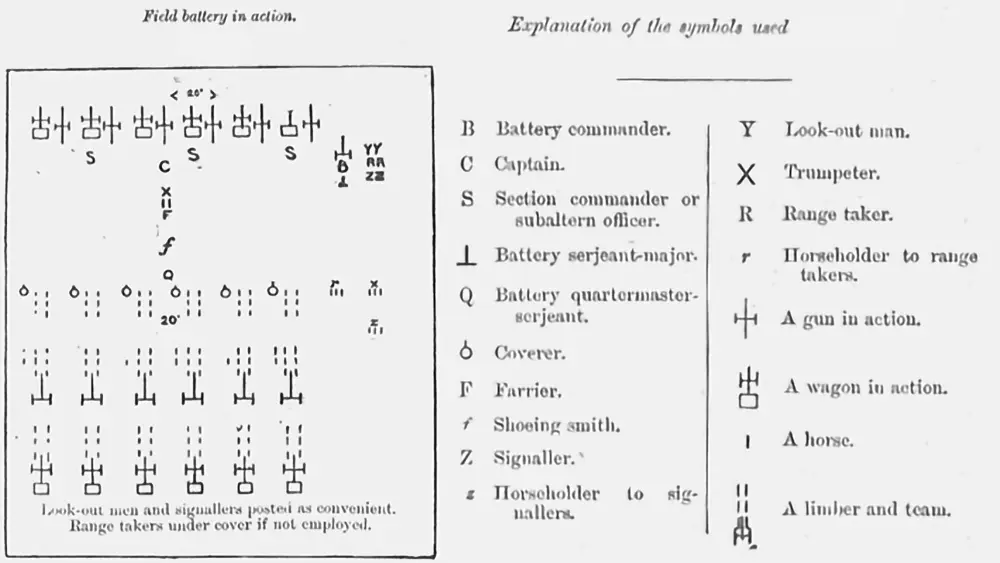
Gun Position delpoyment
The diagram above is not to scale, the wagon lines are for illustration purpose's only, as in action they would be much further back, usually at least two or three miles or more to the rear.
Employment
The deployment of a battery of 4 x 15 pounder or 6x18 pounder guns in the first years of the first world war, was not so quick or as precise as it is today, there was no hand held GPS to find your location, no computers to work out the bearing and elevation for you and in the beginning no Metrological information, and no mechanical transport either, so each battery had to work out the battery's position from a map using a protractor and compass, then from the battery center give the guns the zero line, each gun would then set its sights to the center point, all would then be in line. Then work out the map range to target and convert it into a bearing and elevation using range tables and then every 12 hours firing a mission to find the "Correction of the Moment", that is to say; what the prevailing weather conditions were at that time and at that place, the atmospheric pressure, the temp, wind speed; which includes the direction of the wind, rain and hail all have a bearing on the trajectory of the shell from the very moment it leaves the barrel until it hits the ground and explodes or in the case of a shrapnel shell at a predetermined height above the ground.
To get the "Correction of the Moment" the Observation Post (OP) officer would pick a target; something prominent and easily recognizable if possible on the enemy trench line, he would then work out the Grid reference, bearing and elevation and direction to the target from his position, using a map and protractor (Deg's) and type of fire mission, in this example "Registration".
The OP Officer would then give orders to the guns via his Signaler/telephonist, these men were also trained to use Heliograph and signal lamp (No Radios then), the command post would then plot the Observers target information on to a map, this would also include the OP's location and direction (Obs to tgt) this would enable the command post to adjust on to the target from the corrections given by the OP.
The Command Post (CP) would give the guns the order to load i.e. "Battery Action", "No 3 Load", No ammunition type orders were given as pre-1915 there was only one type - shrapnel.
The No1 of No 3 gun would then order "Load" then the CP would work out the Bearing and elevation to the target from the gun position and give the bearing and elevation to be fired on, to the guns. The No's 1 of No 3 gun would report "Ready", and the CP would give the order to fire, on firing; the CP telephonist would report "Shot" followed by a time of flight in seconds [T of F] to the observer.
Using the direction of Observer to target, the OP Officer would make adjustments to the fall of shot, by giving left or right add or drop corrections to correct his line, using the graticals in his binoculars in the CP this would be calculated into gun data i.e. a left correction from the OP may well be an "Add" correction according to the position of guns on the ground.
Angles in WWI would be made using degrees, 360° to a circle. Milliradians or mils, 6,400 to a circle, were not introduced until after WWII.
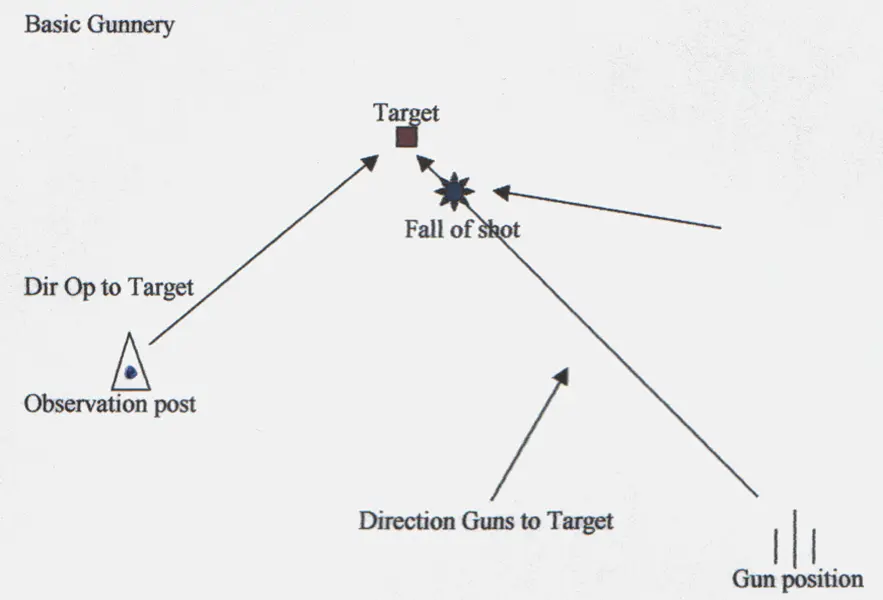
OP and Guns
As you see in the above example the "Left" correction from the OP to bring the fall of shot on to the Dir of Obs-Target line is in fact an "Add" correction applied to the guns, and a "Add" or "Drop" correction from the OP, along the Dir OB target Line, would be a "Left" or "Right" correction applied to the guns, a combination of orders could also be given.
Sources and Resources
Header image: Canadians loading an 18 pounder WWI LAC (Wikimedia)
Derek Driscoll's original pages
An Introduction to Basic Gunnery used in the First World War
18pr Q.F Field Gun Mk1
Ammunition for the Q.F. 18 pr Field Gun
Limber (Ammunition Wagon)
Q F 18-pounder field gun
Q.F.18 Pr Field Gun Battery Deployment
Derek Driscoll's references
Early British Q.F. Artillery by Len Trawin, ISBN 1-85486-154-9, Nexus Special Interests Ltd., 1997.
Gun Drill for Q.F. 18 Pr Mark IV Gun: HMSO 1934
Other References
18-Pdr QF Gun (Militaria)
18 pounder artillery gun (Picryl)
18 pounder artillery gun (Wikimedia)
18 pdr QF field gun M. 1904 (Bulgarian Artillery)
QF 18-pounder gun (Wikipedia)
Lead picrate - Wikipedia
Limbers and Caissons (Wikipedia)
Milliradian (Wikipedia)
Mishap to Mainstay (Key Military) - Some great photos of the 18Pdr, including one from 266 Bty!
Modern Munitions of War - Nature, July 29, 1915
Picric acid - Wikipedia
Researching soldiers of the British Army in the Great War of 1914-1918 (Long Long Trail)
Shell (projectile) - Wikipedia
The Dreaded Lyditte Shell - Bay of Plenty Times, Volume XXIV, Issue 3940, 20 December 1899, Page 2
What is a Lyddite shell? - Rebellion Research
World war 1 artillery ammunition, diagram (Picryl)
